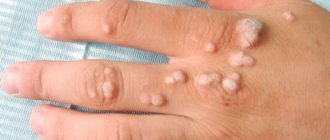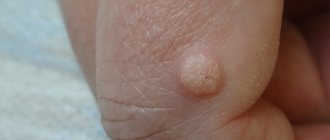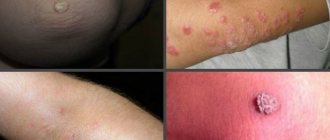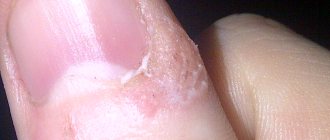Condylomas are specific growths on the surface of the skin. Their appearance is caused by the presence of the papilloma virus in the human body. Many people ask the question: can condylomas go away on their own? Answer: yes, in most cases of HPV infection, genital warts go away on their own within 2 years. But, even if the condylomas go away on their own, the virus remains in your body. In some cases, without treatment, condylomas grow into large cluster formations.
Rice. 1. Condylomas are caused by the papilloma virus
What can I do to make plantar warts go away?
There are no methods that are guaranteed to make skin lesions disappear on their own.
Perhaps if you strengthen your immune system, they will actually disappear.
True, there are problems with this too.
There are no reliable methods to strengthen the immune system.
There is no guarantee that if it strengthens, the warts will go away.
But if you are ready to wait and hope, and you have nowhere to rush, you can try to normalize the activity of the immune system.
This can be done with the help of doctors or on your own.
The independent effect on immunity is as follows:
- rejection of bad habits
- normalization of body weight
- high physical activity
- regular temperature changes
- healthy lifestyle
- good nutrition
- taking vitamins, etc.
A healthy body not only has a healthy mind, but also a good immune system.
Perhaps if you shift your lifestyle in the right direction, there will actually be fewer warts.
In what cases can condylomas go away on their own?
Without proper treatment, condylomas can go away on their own due to several reasons:
- the penetration of the virus into the human body stops, as a result of which its concentration in cells decreases;
- human immunity is restored as a result of therapy;
- the formation of condylomas can be seasonal, so they appear most often in autumn or spring when the body’s defenses decrease;
- after competent treatment of diseases such as chlamydia, genital herpes, gardnerellosis and others.
- normalization of vitamins and microelements in the body.
Rice. 2. Condylomas can go away on their own
Warts do not go away - what to do?
So you've been waiting 10 years for your warts to go away.
But for some reason they remain in their place and don’t go anywhere.
What to do?
There is only one way out - you need to fight these warts.
Everyone perceives this struggle differently.
Someone goes to the clinic, where the doctor removes all the formations on his skin in a few minutes.
After this procedure, you can forget about warts for a long time, or even forever.
Some take a more difficult route.
They search the Internet for folk recipes.
They are trying to cauterize this formation with celandine.
They go to the pharmacy and buy various patches, ointments, solutions that are supposed to destroy the wart.
Sometimes their efforts can actually be crowned with success.
But for most people this approach is fraught:
- suffering
- skin burns
- complications
- scars
- failure in the fight against warts
Is it worth wasting time on useless procedures?
It is much easier to remove warts in a clinic using laser or radio wave procedures.
How to understand that a wart goes away after celandine?
Often people try to remove a wart with celandine.
They usually suffer chemical burns to the skin.
In this case, the wart remains in its place and does not go anywhere.
But it’s hard for a person to believe that grandma’s “time-tested” method didn’t work.
So he searches the Internet for signs that the wart has begun to go away.
Among these signs he may encounter:
- redness
- peeling
- hardening, etc.
Encouraged by the presence of such signs, the person continues to wait for recovery.
But it usually doesn't happen.
Traditional methods are often dangerous and not very effective.
To remove warts, consult a dermatologist.
Clinical picture of warts
Externally, warts are dense nodules with a diameter of 1 to 10 mm (sometimes more), round or polycyclic in shape. Their surface is covered with cracks, horny layers, and vegetations. The color of warts often does not differ from the healthy skin surrounding them, but under a magnifying glass you can see black-brown dots, which are capillaries filled with blood clots.
The rash can be represented by either one element or multiple, randomly located isolated nodules. After a wart is removed, new ones (daughter ones) may appear around it, arranged in a circle. Warts are localized in easily injured areas: hands, fingers, knees. Localization of warts on the fingers and palms leads to changes in the skin pattern. In this situation, the recovery of fingerprints is a sign of recovery.
There are several types of warts.
Common warts
Dense, dry, limited, painless keratinized elevations with an uneven villous surface, the size of a pinhead to a pea. They can merge to form large plaques. Most often located on the hands.
Plantar warts
They are a type of common warts - they appear in places where shoe pressure is applied, especially in those who sweat a lot. Very dense, keratinized, gray-dirty plantar warts are characterized by severe pain that prevents walking; sometimes cause temporary disability.
Flat or juvenile warts
They usually occur in children and young people. They look like round or irregularly shaped flat nodules that are located on the back of the hands, as well as on the skin of the face. The appearance of flat warts is promoted by skin irritation (they often occur along the course of scratches, cuts, etc.).
How long does it take for a wart to heal after cauterization with nitrogen?
Warts are often removed with liquid nitrogen.
This is the simplest method of dealing with them.
It's also the cheapest.
But this method is also the most unpleasant and ineffective.
It often causes more suffering to the patient than the wart itself.
After cauterization with nitrogen, a focus of inflammation is formed.
With a short exposure time of the nitrogen swab, only small warts can be removed.
Medium and large ones do not pass.
To destroy them, it is necessary to increase the exposure time to nitrogen.
But increasing the exposure time leads to an increased risk of severe inflammation and scarring due to deep skin damage.
If you still have cauterization with nitrogen, you need to wait 1-2 weeks for healing.
After this, the doctor will examine the skin.
If the wart does not disappear, the procedure will have to be repeated.
Can a wart go away without external influence?
If you leave the growths alone, you will not spread the virus to other parts of the body and prevent self-infection. Warts can disappear on their own, without external influence, but only over time. This is true for youth and plantar.
Despite the possibility of self-healing, warts with HPV must be removed, especially in places of frequent injury. If formations appear, you should immediately seek help from a dermatologist.
The appearance of warts in the form of condylomas is dangerous. Highly oncogenic types of HPV that cause genital warts are, under certain conditions, the cause of cervical cancer. They don't go away on their own.
They pose a health hazard, are highly contagious - transmission of the virus occurs in 9 out of 10 cases - specific localization, which causes discomfort, in some cases pain, inflammation.
In this case, cryodestruction (freezing with liquid nitrogen), hardware methods - laser cauterization, radio-knife, diathermo-electrocoagulation, and chemicals with a destructive effect - are more often used.
Methods of hardware surgery and freezing are used for formations on the arms, face, legs, and intimate area. Chemical drugs are widely used for the appearance of plantar warts.
The removal procedure is absolutely painless. It assumes quick results, but does not guarantee the absence of relapse. Sometimes traditional methods are used. Celandine has gained particular popularity.
At home, a lapis pencil, Verrukatsid, comes to the rescue. They allow you to eliminate formations by cauterization.
Home methods eliminate the source of infection, preventing further spread of the disease.
How are warts removed in modern clinics?
The following methods are used to remove warts:
- electrocoagulation
- laser
- radio wave removal
- surgical excision
Each method has its own advantages and disadvantages.
Surgical removal is rarely used.
It carries a higher risk of infectious complications.
Basically, the surgical method is used only for very large formations or in the absence of technical capabilities for laser or radio wave procedures.
Laser
Many centers offer laser wart removal.
The essence of the procedure is the gradual evaporation of the formation using a laser beam.
It heats the tissue, causing it to instantly evaporate.
In this case, no charring occurs.
There is no heat in adjacent areas of the skin, so there can be no burn.
The laser has many advantages:
- During laser removal, the instrument does not come into contact with the wound, so there is no risk of infection
- high precision of exposure allows no damage to surrounding tissues
- the virus that causes the wart to recur after removal is destroyed
- wounds heal faster after laser
- blood coagulates, so there is no bleeding
- bacteria are destroyed, so there are no infectious complications (the wound after the laser is sterile)
But there are also disadvantages.
You cannot cut a wart with a laser.
The edges do not heal well after this method of removal.
If there are large formations, they cannot be removed so that the skin can be sutured.
Thus, the laser does not remove the wart, it destroys it.
There is no material left that could be sent for histological examination.
Therefore, laser removal is used for small and medium-sized formations.
Exclusively in situations where there are no signs of precancerous processes, there are no papilloma viruses of high oncogenic risk in the skin.
That is, when there are no indications for histological examination.
Electrocoagulation
Using electrocoagulation, formations of any size can be removed.
The wart can not only be destroyed, but also separated from the body if necessary.
Therefore, it is possible to conduct a histological examination of the removed skin formation, if necessary.
The ball electrode can be used to treat the skin after removal.
In this case, the risk of relapse is reduced because the viruses die.
But there are also disadvantages.
The thermal effect extends to nearby tissues.
Therefore, scarring processes are possible.
Radio wave removal
Replaces electrocoagulation.
A method similar in essence, only more advanced.
The device for radio wave removal of warts operates in cutting or coagulation mode.
That is, it can both remove a skin formation and destroy it.
The cuts made are perfectly smooth and thin.
Therefore, the wound heals faster.
If necessary, formations of any size can be removed and stitches applied.
Coagulation is performed simultaneously during the cutting process.
Whatever method is used, removal is carried out using anesthesia.
The person does not feel anything during the procedure.
Because a drug is injected into the skin to block the transmission of nerve impulses.
How to increase the body's chances of coping with warts?
To make warts disappear, you need to strengthen your immune system. In addition to using immunomodulatory drugs, you should adhere to the following tips:
- Avoid stress, because hormones that are released during stressful situations in the human body suppress and destroy the immune system.
- Lead a healthy lifestyle, do exercises. When all muscle groups work, the blood does not stagnate, the cells receive the right amount of oxygen.
- Maintain a sleep schedule. It has been proven that disruption of biological rhythms makes the body susceptible to infections.
- Get examined by a dentist, gynecologist, urologist, or ENT specialist in a timely manner. Do not trigger acute and chronic diseases.
A rational lifestyle, positive emotions, and walks in the fresh air will significantly increase immunity and help cope with infections in the body.
Unfortunately, after all the warts disappear, the virus will still remain in the blood. Therefore, it is important to treat the root cause so that relapse does not occur. The main preventive measure is the use of individual personal hygiene items. Do not forget that a healthy intestine and a strong immune system are closely related, so do not neglect nutrition, eat foods rich in vitamins A, E, C. The measures are very simple, but following them will help maintain immunity and protect the body from disease.











